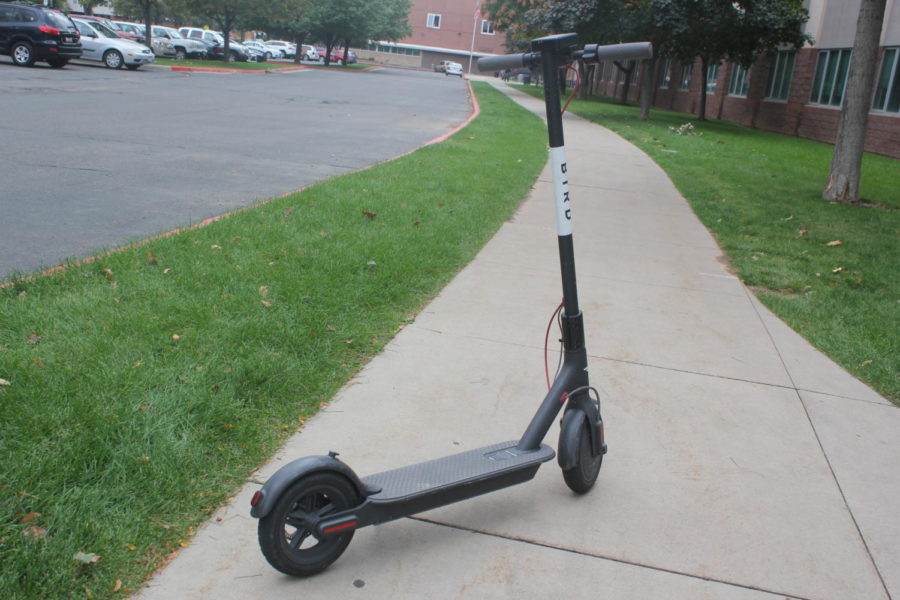E-Scooters Hit Highland
October 12, 2018
This summer, while the peace of two stress-free months was flourishing, Salt Lake City was invaded by a mysterious, sometimes deadly foe: Electric scooters.
Salt Lake City wasn’t the first city to experience a scooter onslaught — the scooters, masked in a myriad of companies, first hit big cities like San Francisco. In their original form, the scooter companies would do first, ask later, dumping huge quantities of scooters on the city sidewalks and letting events unfold. In more recent roll-outs, however, they’ve asked for permission to enter cities, and SLC’s mayor readily gave it to two lucky scooter companies: Lime and Bird.
If one has been anywhere, anytime, in the last few months, they’ve probably seen people riding at least one of these scooters. They’ve even been spotted here at Highland. The black and white Bird scooters hit the streets first, in late June, followed by the white, and, true to its name, lime green Lime scooters.
They are not, of course, fuzzy, sky-sharing friends, but scooters with electric motors that can be ridden by going through a few simple steps on an app. First, download the app for either Lime or Bird on mobile phone. Then, set up a link with a credit card.
When you’re ready to ride, you just scan the handy barcode on the scooters to unlock them, which then lets you ride for however long you’d like, charging you a certain amount depending on how long you stay on the scooter. The scooter can, in some cases, even serve a practical purpose, but people our age, students at Highland included, tend to ride them more for fun than for anything else.
“They’re really fun, “ Says Highland senior Andrew Pignanelli. “They get up to almost twenty miles an hour. They get up hills pretty easily, especially if you’re the only person on them.”
Pignanelli has only ridden the scooters a few times, and uses only Lime scooters, as they follow regulations less stringently, letting riders check a box affirming they’re over eighteen instead of scanning in their personal I.D’s, like those who ride on Birds. For Pignanelli, the scooter’s biggest selling point is the cost.
“They’re ridiculously cheap,” Pignanelli says, “I don’t know how they’re making any money.”
The scooters have the same going rate: It’s one dollar to start your ride, and then fifteen cents per mile. Extremely cost efficient for high schoolers who don’t have high budgets.
And yet, the scooters do have problems. Other than ingraining themselves in our lexicon, the scooters, or, more importantly, the companies that run them, don’t seem to care for enforcing the rules of safe riding. While each scooter brand states clear rules- Helmets are required, you cannot use the sidewalks, and you must be eighteen or older to ride — these don’t translate into reality. Pignanelli has thought long and hard on the issue of scooters safety, stating,
“They are not the safest in the world. They require you to wear helmets, but nobody does.”
At the same time, however, Pignanelli thinks that the danger of the scooters is overhyped.
“You could see some people getting hurt,” He says, “But at the same time, I don’t think that many people are falling off. They can be dangerous, but I don’t think they really are, in reality.”
Still, Pignanelli raises valid concerns.
The companies say that helmets are required, yet they don’t provide you with one. They say that you can’t ride on the sidewalks but don’t have any way of seeing if you’re following that rule. And only one of the companies, Bird, requires you to show them your valid driving license, which is easily worked around by asking someone you know to show it, as the companies can’t verify that the person who showed the license is the one who’s actually riding the scooters.
Charging the scooter presents problems of its own. At the end of the day, a chip in the scooters will alert potential chargers of the scooter location. The people then flock to pick up the scooters, bringing them back to their homes to charge them for five to twenty dollars a charge, depending on how much time the scooters need to charge.
These chargers, however- Known as ‘Juicers’ for Lime, and, somewhat self-explanatory, ‘Bird hunters’ for Bird– have to use their own electricity for this, and they don’t get any benefits from Bird or Lime. If the scooters they pick up are broken, or won’t charge, they don’t get anything for them, and they constantly have to fight off other chargers- Sometimes literally.
And statistics would disagree with Pignanelli’s claim that the scooters aren’t really dangerous.
Scooter injury reports have spiked at hospitals this year, with a 162 percent increase in scooter crashes nationwide from 2017 to 2018.
But despite these numerous problems, there may be hope yet for e-scooters. Campaigns have started to post stickers advocating against sidewalk scooter use in hopes of dissuading users. Both companies have held events that educate riders on proper, safe scooter etiquette, and offer free helmets to riders who show up.
As for us here at Highland? Go ahead and ride the scooters all you want. After all, all you have to do is check a box.






























